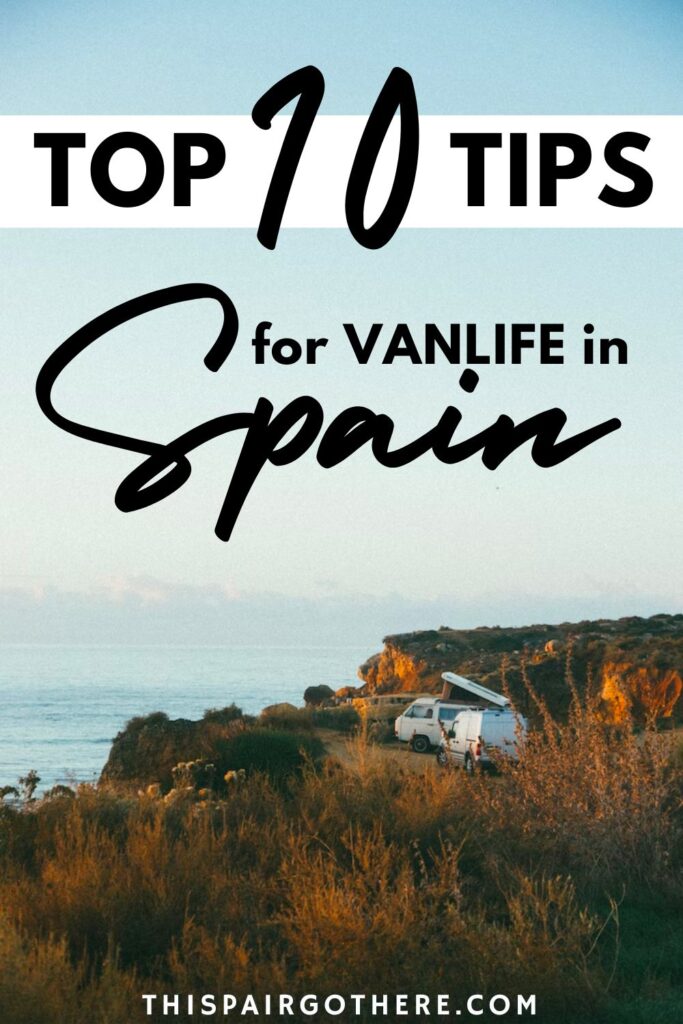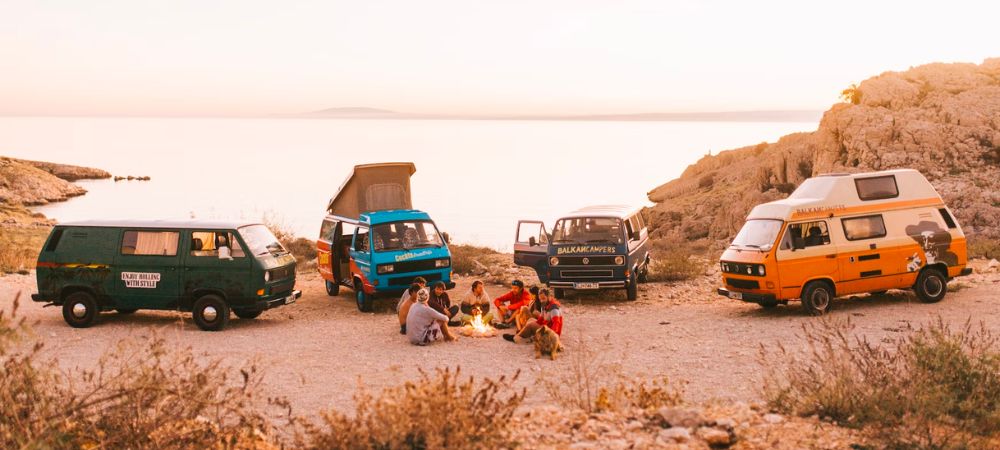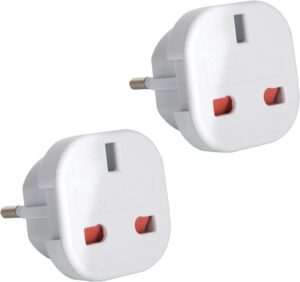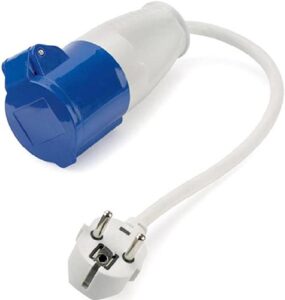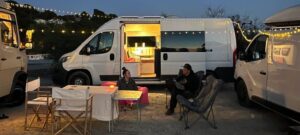So, you’re considering taking your campervan/motorhome to Spain? Great choice! Van life is Spain is top-notch. We could spend hours and hours ranting and raving about why Spain is one of the best countries in Europe to travel by road, but instead, we will be giving you 10 helpful hints on ways to make travelling around this foreign land a little easier. This post has been carefully curated to take the guesswork out of exploring Spain by van, car, motorhome… or whatever vehicle you may have. Consider this your one-stop shop to learn what you need to know before beginning your van life adventure in Spain.
We have 10 top tips separated under three handy headings: driving, parking, and miscellaneous.
Driving in Spain
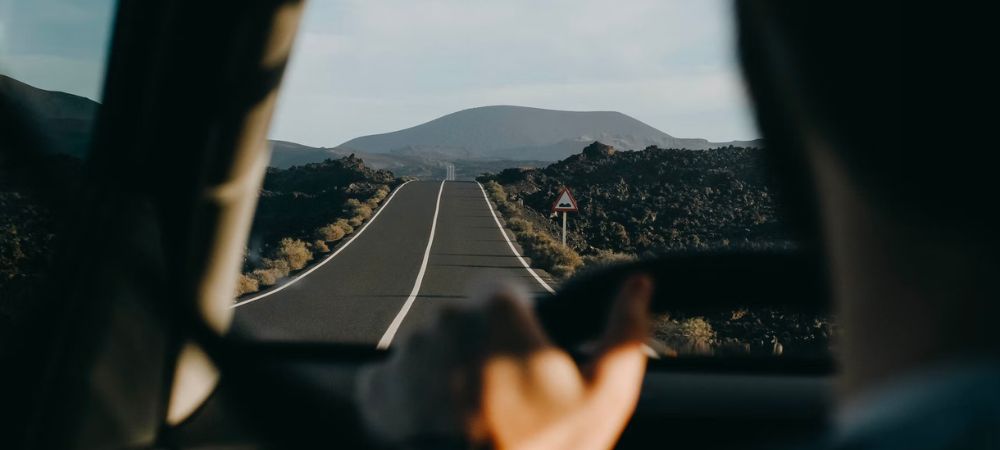
AVOID toll roads
When arriving in Spain make sure to click avoid toll roads on Google or Apple maps. Unlike in other European countries, these roads do not save you much time and can be extremely expensive (approximately 1€ per 8km). Typically you may save 10 minutes per hour of driving if using toll roads.
Furthermore, non-toll roads will often take you through small villages that ooze authentic Spanish charm and are much more scenic. You may also be treated to vast untouched landscapes that very few travellers stumble upon! A preferable sight to never-ending motorways.
Finally, the quality of the non-toll roads is completely fine. Unlike other countries, you will still be on a dual carriageway, or at worse, a well-tarmacked single carriageway the majority of the time. Sure, the roads aren’t going to be as smooth as the toll roads, but that is the price of avoiding them.
We personally don’t recommend toll roads as we can’t justify the price for the minimal amount of time saved, however, if you are Mr (or Miss) moneybags, by all means, take the tolls!
Speed Limits in Spain
When driving in Spain it is important to know the speed limits to avoid any unnecessary fines.
We personally found the roads to have a significant lack of speed limit signage, and fell victim to a speeding fine! Oops. So, learn from our mistakes and familiarise yourself with the limits before entering Spain.
First and foremost, Spain has different speed limits depending on the type of vehicle you are driving and the class of road.
There are 4 main classes of road.
Motorways
Cars – 120kph (74mph)
Vans and Buses – (including Motorhomes) – 100kph (62mph)
Standard Raod Types 1
This is an extremely vague description, adding to the ambiguity of the Speed limits. The best definition of this road type we found is: “one-way roads, roads with dual carriageways for at least one direction of traffic, and roads with shoulders 1.5m or more in width“.
Cars – 100kph (62mph)
Vans and Buses (including Motorhomes) – 90kph (55mph)
Standard Raod Types 2
This road type is any road that doesn’t fall in the categories above and isn’t a built-up area. This is one of the most common road classes when avoiding toll roads.
Cars – 90kph (55mph)
Vans and Buses (including Motorhomes) – 80kph (49mph)
Built up areas
Built-up areas include cities, towns, and even rural villages.
All vehicles – 50kph ( 31mph)
Although the speeds listed above are the legal limit, please be vigilant of the road signs as often times the speed limit may be lower than you think. A common sight is a 70kph limit, on a road you would expect to be a 90kph (a standard road type 2).
Furthermore, if you see a road sign which is a blue circle with a number in white in the centre. This represents the minimum speed limit for the road. Therefore, if your vehicle is incapable of reaching this speed, you may not use this road.
For more information regarding speed limits in Spain, check out this post by the RAC.

Be wary of differing driving habits
Over the 5 months we have spent driving around Spain we have found that Spanish drivers are considerably more aggressive than British drivers. Specifically, they have a completely different attitude towards overtaking.
In Spain, you may find yourself with someone almost touching the back of your vehicle (up your chuff) before pulling out to overtake. Then they swiftly cut back in front with not much room to spare. This is standard practice for the locals. This can be daunting if you are unfamiliar with Spanish driving but becomes second nature in no time.
Another difference is how Spanish people use a roundabout. There is a largely unspoken rule of negotiating roundabouts, and quite frankly it’s insane. Typically, if the roundabout has two lanes, people will tend to stay in the outside lane even if they are taking the last exit. It is bonkers. The inside lane is largely redundant in Spain. If you do find yourself in the inside lane, you better hope the roundabout isn’t busy, as (no offence) Spanish drivers aren’t the most courteous, and you could find yourself stuck going round and round.
Finally, Spanish people use their horns very liberally and are extremely impatient. If you are not on or above the speed limit, you will be getting honked at and overtaken.
Although we don’t want to perpetuate that one nationality is better at driving than another, we have been crashed into twice in Spain – both times we have been parked and inside of our van! So, read into that what you will!
Parking – van life Spain
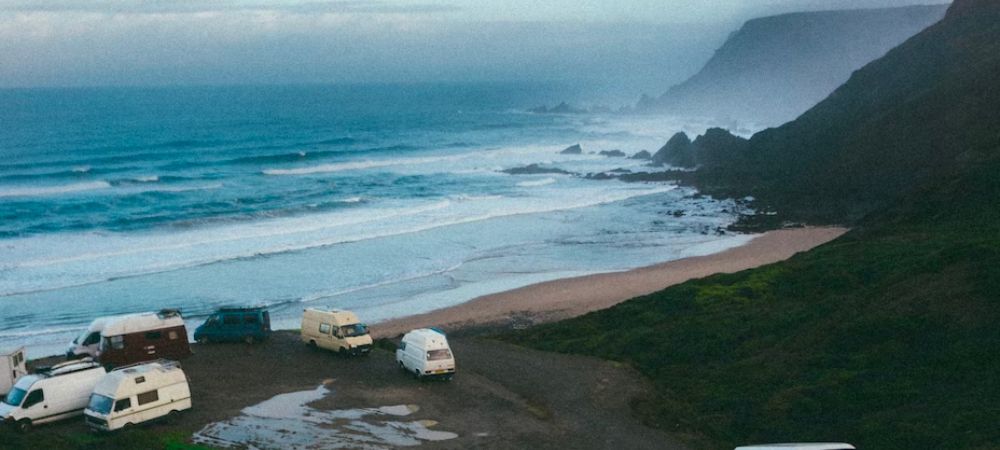
Before we get into some handy parking tips for van life in Spain, we are going to quickly cover the legality of wild camping in Spain. Wild camping in Spain is illegal and can carry a fine if caught doing so. Despite this Spain is arguably the most van friendly country in Europe.
This is because there is a small technicality to bypass this law. It’s perfectly legal to park your vehicle almost anywhere in Spain (whether it’s a car, van, or even a large motorhome), so long as you are staying in a place where parking is allowed and not explicitly forbidden by way of a sign. What is not permitted and constitutes as camping is setting up camping chairs, and extending an awning, etc. However, if you are parked up and staying in your van and not sprawling out you should be fine.
To learn more about this we recommend reading We Will Nomads post about parking in Spain, it is extremely insightful and goes into much more depth regarding what constitutes as camping. You can find this linked here.
Don’t let the legality of wild camping in Spain put you off visiting. Over the 5 months we have spent in Spain, we have not run into any bother regarding wild camping.
Download Park4Night
Park4night is the most common app used in Spain (and all of Europe, in fact!) to find great campsites and secluded wild camping spots. Park4night is also useful when trying to find services such as laundry and places to refill your water tank.
It is a free app with an option to pay a monthly or yearly subscription to unlock all features of the app. We currently only have the free version and have been completely content. However, we do intend on paying the annual subscription of £9.99 in the coming month as it allows you to leave reviews, and help even more people trying their best to live their life in a van in Spain… and beyond.
Unfortunately, although it’s undeniably convenient, by using Park4Night you are essentially adding to the over-tourism of these once-untouched scenic spots.
If possible, we recommend finding a spot that has not been documented on Park4night, especially if you are in a rural area. One of the best ways to scout out undiscovered spots is by browsing on Google maps whilst in Satellite view.
Alternatively, we have written in-depth posts for over 20 destinations in Spain where we have camped in our van. All spots have been tried, tested, and approved by us. We discuss all aspects of each spot so you know what you are getting yourself into prior to arriving. The analysis includes location, available space, facilities, signal, views, and so much more.
Discover all of the places we have lived our van life dream (so far) and written about in Spain here.
Alternatively, you can check out every parking spot we have stayed in throughout Europe down below.
Aires in Spain
Aires are free camping areas which you can find not only in Spain but throughout the majority of mainland Europe. They are often run by the local councils in Spain and provide basic facilities to do all the dreaded van life chores. Aires are not too glamorous, and oftentimes overcrowded.
Typically you will find a freshwater supply, grey, and black water disposal areas, and several parking spaces. If you are lucky, you may even get an aire with an electrical supply, however, these are pretty rare and generally will have an additional fee.
In order to find local aires, we recommend looking on park4night. They are shown as a small green motorhome icon on the app.
We found that northern Spain had considerably more aires than central and southern Spain.
Without a doubt, our favourite Aire in Spain was in Segovia. It is certainly not perfect, but it was clean and within a short walk to the heart of this historic town. To discover more about this aire, click the link below.
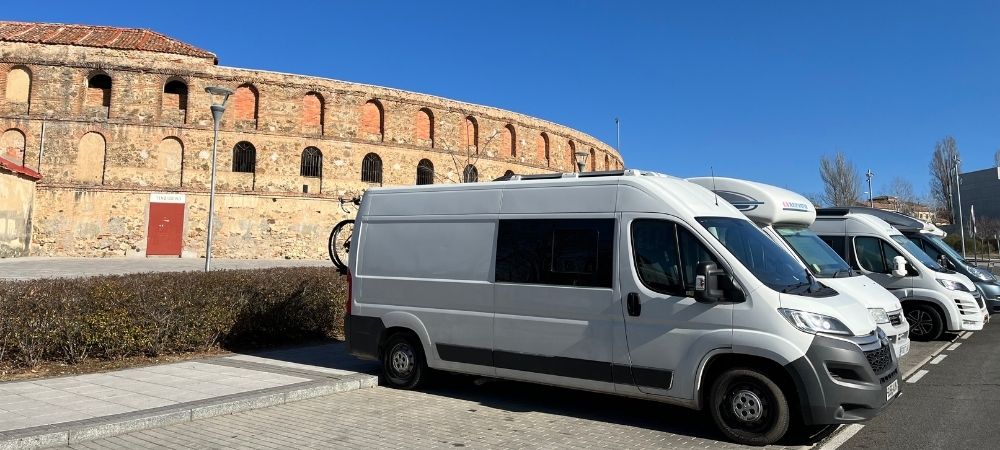
Parking a van in a city in Spain
Parking in a city in Spain is an absolute nightmare. From congestion to running into crooks, and just generally feeling unsafe. It is arguably one of the worst parts of visiting this amazing country.
Firstly, you will struggle to find a parking space anywhere near the city centre of any major city. If you are lucky and do snag a space – be vigilant as car robberies are commonplace! We parked our van in the city centre of Valencia, Barcelona, Malaga, Seville, and a few other cities. Personally, we experienced the most issues in Valencia and Seville. We never felt truly safe leaving our van whilst we lived our best life in each major city in Spain.
In Seville, a man threaten to throw nails under our tyres if we did not pay him to stay in a FREE car park. Furthermore, when we stayed in Valencia we woke up to find the neighbouring vehicles’ front windows to be smashed. We were shaken and moved on immediately.
Below we have linked in-depth reviews of cities we parked overnight in Spain. All of these spots are free and we had absolutely no issues with them.
Where to park overnight in Barcelona
Where to park overnight in Valencia
However, although we had no issue with the spots listed above, if you can justify the expense we highly recommend staying in a campsite, or at least a locked/guarded car park when visiting a city.
You can find many reasonably priced campsites within walking distance (or worst case scenario – a cycle or bus ride away). By opting to stay in a campsite, you will have peace of mind – which is invaluable!
Miscellaneous van life things to consider in Spain

Bike rack rules / rear-loaded equipment rules in Spain
In Spain, you are allowed a bike rack on your vehicle. However, you must have a rear (V-20) warning sign. This sign is Specific to Spain so make sure you are buying the correct one before heading there. You can find one on Amazon here, or in a local Decathlon shop.
The Spanish (V-20) warning sign is:
- 50cm x 50cm
- Aluminium
- 3 red stripes / 3 white stripes
Typically, only one sign is needed and should be positioned as shown in the photo below. However, if your bike/load exceeds the width of your vehicle (wider than the wing mirrors) then you will need 2 signs configured as shown below.
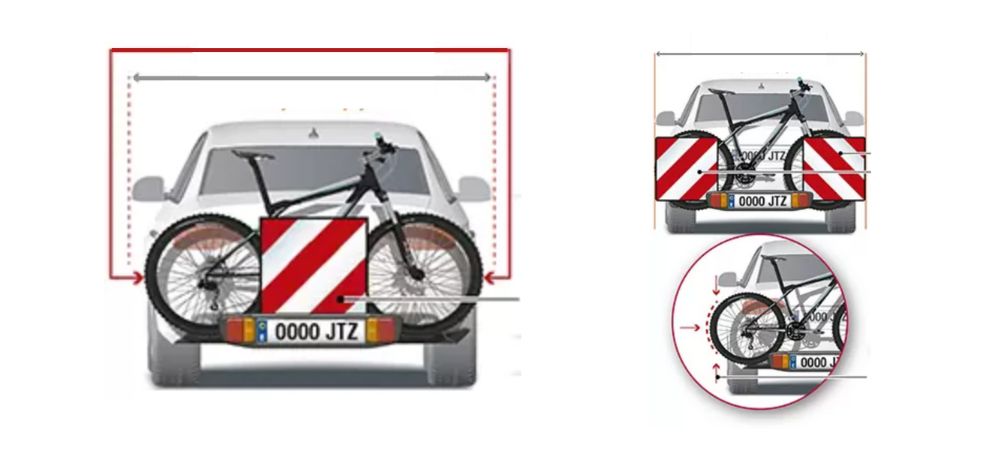
Furthermore, there are regulations regarding how far out the back of your vehicle your bikes (load) can stick. The distance that the load can protrude depends on if you can divide it or not between 10% (divisible) or 15% (when the load is unable to be indivisible or separated). A bicycle is considered a divisible load so depending on the length of your car, you can carry 1, 2, 3 or 4 bicycles.
Failure to comply with the rules and regulations can result in an onet-the-spot fine of up to 200€.
Bring European electrical adapters
Not all campsites have the same standard adapters to plug into. Many campsites in Spain are slightly primitive and will simply have a standard European plug socket to plug your van into. Although seasoned travellers will know this, it was a slight shock to us on our first van life trip to Spain. Luckily we were coincidentally prepared.
Make sure you have the attachments linked below and you should be fine. We personally think you only need A. and B. However, although technically unnecessary, it could be handy to have C. as well simply because its easier.
A. 240V 3 Pin UK Electric Hook Up Adapter
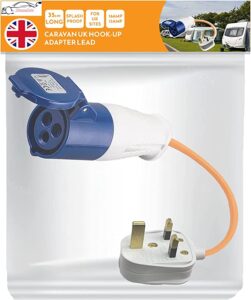
Furthermore, adapters are also useful for charging your appliances out with your van – especially if you are travelling in winter and solar power is a rare commodity! We found ourselves charging our laptops on the go from time to time, particularly in longer cloudier winter periods!
One thing to consider is if you are unlucky and break down and need to leave your van for any reason, you can still use charge up your devices in a hotel room!
Finally, one more electrical accessory which we deem to be extremely useful is an extremely long hook up extension cable. We have noticed cheaper campsites tend to only have a few hook up points dotted throughout the site, and can often be quite a long distance from where you are parked. We recommend this 25m extension lead from Amazon.
Learn the Spanish language basics
Most Spanish people have a fairly good grasp of the English language, however, that is not the case for everyone, and nor should it be. It is important to remember that we are a guest in their country, and because of that we should at least make a small effort to learn the language.
We recommend learning yes, no, please, thank you, and the numbers from 1-10. This will make your life much easier. We also found the locals were much friendlier when they noticed us trying our best to muddle through the language.
If you want to take it one step further, why not consider buying a phrase book to really wow the locals! Check out this handy Spanish phase book by the Lonely Planet right here.
If there is anything else you need to know prior to visiting Spain, why not check out our page discussing all things Spain, from the best places to park overnight, to in depth itineraries? Alternatively, If that’s not enough information for you, we are an open book, leave us a comment below and we will get back to you as soon as possible!
If you liked this post, pin it… pretty please xoxo
